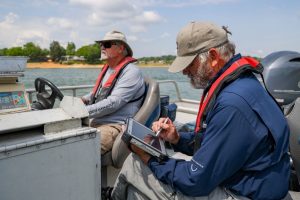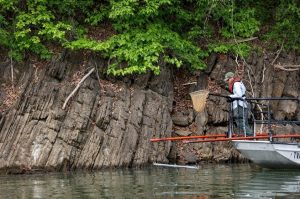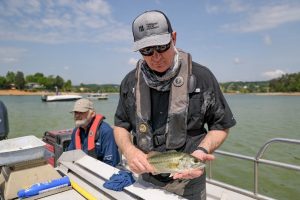A spring survey of Douglas Reservoir has provided clues about how Hurricane Helene and storm debris may have impacted fish and the local fishing industry.
The good news?
“It seems like we’re seeing good fish results,” Lyn Williams, Fisheries and Aquatic Monitoring Manager, said.
 Monitoring TVA’s reservoirs is part of a watershed-wide program that ensures the aquatic creatures of the Tennessee River system are healthy. When these species thrive, communities thrive – sportsmen, campers and other outdoor enthusiasts all contribute to the vitality of local economies.
Monitoring TVA’s reservoirs is part of a watershed-wide program that ensures the aquatic creatures of the Tennessee River system are healthy. When these species thrive, communities thrive – sportsmen, campers and other outdoor enthusiasts all contribute to the vitality of local economies.
“We monitor 15 to 20 reservoirs for sport fish to make sure we’re doing our part along with the Tennessee Wildlife Resources Agency,” Lyn said. “In the fall we have a similar program, but we’re looking at every fish, not just sport fish. They’re the canaries in the coalmine.”
These types of programs help protect native habitat and native species all throughout the watershed, ultimately benefitting residents and businesses – and TVA as it manages the river for navigation, flood prevention and power generation.
Each day of monitoring means boating to 12 pre-selected sites, the same ones year after year. The crews spend exactly 30 minutes netting fish and scooping them into the boat for an in-depth assessment.
 This year’s monitoring at Douglas Reservoir was especially important. In the months following Hurricane Helene, many people worried what impact floating debris might have on the water and fish populations.
This year’s monitoring at Douglas Reservoir was especially important. In the months following Hurricane Helene, many people worried what impact floating debris might have on the water and fish populations.
A survey helps provide a fish’s perspective on its changed habitat. It’s possible to detect changes because TVA and partners like the Tennessee Wildlife Resources Agency have a long-running monitoring record.
“Douglas wasn’t actually on the sampling rotation this year,” Lyn said. “But we thought there was good reason to monitor this after Helene. This was a highly impacted reservoir, along with the Nolichucky system. We’ve done this since the 1990s, so we’ll be able to see if there’s any real impact.”
The Douglas Reservoir survey crew liked what they saw.
 “The fish we saw today looked good,” Kurt Lakin, Reservoir Fisheries Biologist, said. “As they continue to take more samples, they’ll continue to see that.”
“The fish we saw today looked good,” Kurt Lakin, Reservoir Fisheries Biologist, said. “As they continue to take more samples, they’ll continue to see that.”
And stable fish populations meant good news – not just for the fish, but the many people who seek them out all summer long.
“Recreation has such an incredible impact on all the communities in the Valley region,” Lyn said. “People come in to fish and to stay. And locals have grown up on these reservoirs, fishing, boating, waterskiing and camping.”
